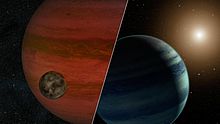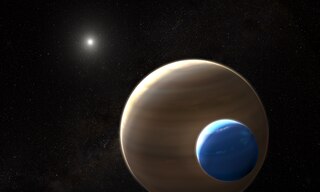
As of 2023 [update] , there have been no positive confirmations of satellites of extra-solar planets (exomoons); however, some evidence in favour of their existence has been produced.

As of 2023 [update] , there have been no positive confirmations of satellites of extra-solar planets (exomoons); however, some evidence in favour of their existence has been produced.
| Host star of the host planet(s) | Planet designation | Planet mass | Planet semimajor axis (AU) | Exomoon semimajor axis | Exomoon mass (ME) | Notes |
|---|---|---|---|---|---|---|
| V1400 Centauri | J1407b [18] | 14–26 MJ | 2.2–5.6 | 0.24 AU | <0.3 | Two possible exomoons residing in small ring gaps around J1407b. |
| 0.25 AU | ||||||
| 0.40 AU | <0.8 | Possible exomoon residing in a large ring gap around J1407b. | ||||
| N/A | 2MASS J1119-1137A or B | 3.7 MJ | 3.6 ± 0.9 separation from each other | 0.004 - 0.009 AU | 0.5 - 1 | Found using the transit method. A habitable-zone exomoon candidate transiting a directly imaged free-floating planet or isolated planetary-mass object. [11] |
| N/A | 2MASS J2117-2940 | 7 MJ | N/A | 0.005 AU | ~0.5 | Candidate exomoon transit detected in Spitzer observations of 2MASS J21171431-2940034. [19] |
| DH Tauri | DH Tauri b | 10.6 MJ | 330 | 10 AU | 318 | Candidate Jupiter-mass satellite from direct imaging. If confirmed, it could also be considered a planet orbiting a brown dwarf. [20] |
| HD 189733 | HD 189733 b | 1.13 MJ | 0.031 | 0.0087 AU | ? | Found by studying periodic increases and decreases in light given off from HD 189733 b. Outside of planet's Hill sphere. [21] |
| <0.00112 AU | ~ 0.015 | Exo-Io candidate; [22] The sodium and potassium data [23] [24] at HD189733b is consistent with evaporating exomoons and/or their corresponding gas torus. [25] | ||||
| Kepler-409 | Kepler-409b | 1.00 ME | 0.320 | 0.222 R Hill | 0.300 | Possible exomoon from transit timing variations, [9] since deemed unlikely. [10] |
| Kepler-517 | Kepler-517b | 7.59 ME | 0.298 | 0.278 R Hill | 0.499 | Possible exomoon from transit timing variations, [9] since deemed unlikely. [10] |
| Kepler-809 | Kepler-809b | 38.02 ME | 0.308 | 0.289 R Hill | 2.931 | Possible exomoon from transit timing variations. [9] |
| Kepler-857 | Kepler-857b | 14.13 ME | 0.376 | 0.208 R Hill | 1.636 | Possible exomoon from transit timing variations. [9] |
| Kepler-1000 | Kepler-1000b | 19.95 ME | 0.534 | 0.235 R Hill | 1.551 | Possible exomoon from transit timing variations, [9] since deemed unlikely. [10] |
| Kepler-1326 | Kepler-1326b | 24.55 ME | 0.2691 | 0.295 R Hill | 6.057 | Possible exomoon from transit timing variations, [9] since deemed unlikely. [10] |
| Kepler-1442 | Kepler-1442b | 14.13 ME | 0.405 | 0.208 R Hill | 1.586 | Possible exomoon from transit timing variations, [9] since deemed unlikely. [10] |
| Kepler-1625 | Kepler-1625b | <11.6 MJ [26] | 0.98 | 0.022 AU | 19.0 | Possible Neptune-sized exomoon or double planet, indicated by transit observations. [27] [7] |
| Kepler-1708 | Kepler-1708b | <4.6 MJ | 1.64 | 0.005 AU (11.7 RP) | <37 | Possible Neptune-sized exomoon or double planet, indicated by transit observations. [12] |
| KOI-268 | KOI-268.01 | 9.33 ME | 0.47 | 0.217 R Hill | 0.817 | Possible exomoon from transit timing variations, [9] since deemed unlikely. [10] |
| N/A | MOA-2011-BLG-262L [28] | 3.6 MJ | N/A | 0.13 AU | 0.54 | Found by microlensing; however it is unknown if the system is a sub-Earth-mass exomoon orbiting a free-floating planet, or a Neptune-mass planet orbiting a low-mass red dwarf star. [29] |
| N/A | MOA-2015-BLG-337L | 9.85 MJ | N/A | 0.24 AU | 33.7 | Found by microlensing; however it is unknown if the system is a super-Neptune-mass planet orbiting a free-floating planet, or a binary brown dwarf system. [30] |
| WASP-12 | WASP-12b [31] | 1.465 MJ | 0.0232 | 6 RP | 0.57–6.4 [ citation needed ] | Found by studying periodic increases and decreases in light given off from WASP-12b. Outside of planet's Hill sphere. [21] |
| WASP-49 | WASP-49b | 0.37 MJ | 0.0379 | < 1.74 RP | ~ 0.015 | Exo-Io candidate; The sodium exosphere around WASP-49b could be due to a volcanically active Io-like exomoon. [22] |
| WASP-76 | WASP-76b | 0.92 MJ | 0.033 | 1.125 RP | ~ 0.015 | Exo-Io candidate; Sodium detected via absorption spectroscopy around WASP-76b [32] is consistent with an extrasolar toroidal atmosphere [33] generated by an evaporating exomoon. [25] |
| WASP-121 | WASP-121b | 1.184 MJ | 0.02544 | ~ 1.9 RP | ~ 0.015 | Exo-Io candidate; The sodium detected via absorption spectroscopy around WASP-121b [34] is consistent with an extrasolar gas torus possibly fueled by a hidden exo-Io. [25] |

An exomoon or extrasolar moon is a natural satellite that orbits an exoplanet or other non-stellar extrasolar body.

Any planet is an extremely faint light source compared to its parent star. For example, a star like the Sun is about a billion times as bright as the reflected light from any of the planets orbiting it. In addition to the intrinsic difficulty of detecting such a faint light source, the light from the parent star causes a glare that washes it out. For those reasons, very few of the exoplanets reported as of January 2024 have been observed directly, with even fewer being resolved from their host star.

HD 189733 b is an exoplanet in the constellation of Vulpecula approximately 64.5 light-years away from the Solar System. Astronomers in France discovered the planet orbiting the star HD 189733 on October 5, 2005, by observing its transit across the star's face. With a mass 11.2% higher than that of Jupiter and a radius 11.4% greater, HD 189733 b orbits its host star once every 2.2 days at an orbital speed of 152.0 kilometers per second, making it a hot Jupiter with poor prospects for extraterrestrial life.

The Hunt for Exomoons with Kepler (HEK) is a project whose aim is to search for exomoons, natural satellites of exoplanets, using data collected by the Kepler space telescope. Founded by British exomoonologist David Kipping and affiliated with the Center for Astrophysics | Harvard & Smithsonian, HEK submitted its first paper on June 30, 2011. HEK has since submitted five more papers, finding some evidence for an exomoon around a planet orbiting Kepler-1625b in July 2017.

Kepler-90h is an exoplanet orbiting within the habitable zone of the early G-type main sequence star Kepler-90, the outermost of eight such planets discovered by NASA's Kepler spacecraft. It is located about 2,840 light-years, from Earth in the constellation Draco. The exoplanet was found by using the transit method, in which the dimming effect that a planet causes as it crosses in front of its star is measured.

Kepler-90g is a super-puff exoplanet orbiting the early G-type main sequence star Kepler-90, one of eight planets around this star discovered using NASA's Kepler space telescope. It is located about 2,840 light-years (870 pc) from Earth, in the constellation Draco. The exoplanet was found by using the transit method, in which the dimming effect that a planet causes as it crosses in front of its star is measured. It orbits its parent star about every 210.5 days at a distance of 0.71 astronomical units.

Kepler-138, also known as KOI-314, is a red dwarf located in the constellation Lyra, 219 light years from Earth. It is located within the field of vision of the Kepler spacecraft, the satellite that NASA's Kepler Mission used to detect planets transiting their stars.
Kepler-419c is a super-Jupiter exoplanet orbiting within the habitable zone of the star Kepler-419, the outermost of two such planets discovered by NASA's Kepler spacecraft. It is located about 3,400 light-years from Earth in the constellation Cygnus. The exoplanet was found by using the transit timing variation method, in which the variations of transit data from an exoplanet are studied to reveal a more distant companion.
Kepler-1625 is a 14th-magnitude solar-mass star located in the constellation of Cygnus approximately 7,200 light-years away. Its mass is within 5% of that of the Sun, but its radius is approximately 70% larger reflecting its more evolved state. A candidate gas giant exoplanet was detected by the Kepler Mission around the star in 2015, which was later validated as a real planet to >99% confidence in 2016. In 2018, the Hunt for Exomoons with Kepler project reported evidence for a Neptune-sized exomoon around this planet, based on observations from NASA’s Kepler mission and the Hubble Space Telescope. Subsequently, the evidence for and reality of this exomoon candidate has been subject to debate.
Kepler-1625b is a super-Jupiter exoplanet orbiting the Sun-like star Kepler-1625 about 2,500 parsecs away in the constellation of Cygnus. The large gas giant is approximately the same radius as Jupiter, and orbits its star every 287.4 days. In 2017, hints of a Neptune-sized exomoon in orbit of the planet was found using photometric observations collected by the Kepler Mission. Further evidence for a Neptunian moon was found the following year using the Hubble Space Telescope, where two independent lines of evidence constrained the mass and radius to be Neptune-like. The mass-signature has been independently recovered by two other teams. However, the radius-signature was independently recovered by one of the teams but not the other. The original discovery team later showed that this latter study appears affected by systematic error sources that may influence their findings.

Kepler-1625b I, a possible moon of exoplanet Kepler-1625b, may be the first exomoon ever discovered, and was first indicated after preliminary observations by the Kepler Space Telescope. A more thorough observing campaign by the Hubble Space Telescope took place in October 2017, ultimately leading to a discovery paper published in Science Advances in early October 2018. Studies related to the discovery of this moon suggest that the host exoplanet is up to several Jupiter masses in size, and the moon is thought to be approximately the mass of Neptune. Like several moons in the Solar System, the large exomoon would theoretically be able to host its own moon, called a subsatellite, in a stable orbit, although no evidence for such a subsatellite has been found.
Kepler-409b is a super-Earth orbiting Kepler-409, a G-type main-sequence star. Its orbital period around the star is 69 days. Kepler-409b has a radius 1.199 times that of Earth and a mass 6 times that of Earth. Its discovery in 2014 was made through the use of the transit detection method. The transit method was performed by the Kepler space telescope.
Kepler-1708b is a Jupiter-sized exoplanet orbiting the Sun-like star Kepler-1708, located in the constellation of Cygnus approximately 5,600 light years away from Earth. It was first detected in 2011 by NASA's Kepler mission using the transit method, but was not identified as a candidate planet until 2019. In 2021, a candidate Neptune-sized exomoon in orbit around Kepler-1708b was found by astronomer David Kipping and colleagues in an analysis using Kepler transit data. However, subsequent research has raised discrepancies about the possible existence of an exomoon, similar to that of Kepler-1625b.
Kepler-1513 is a main-sequence star about 1,150 light-years away in the constellation Lyra. It has a late-G or early-K spectral type, and it hosts at least one, and likely two, exoplanets.
Mamajek thinks his team could be either observing the late stages of planet formation if the transiting object is a star or brown dwarf, or possibly moon formation if the transiting object is a giant planet